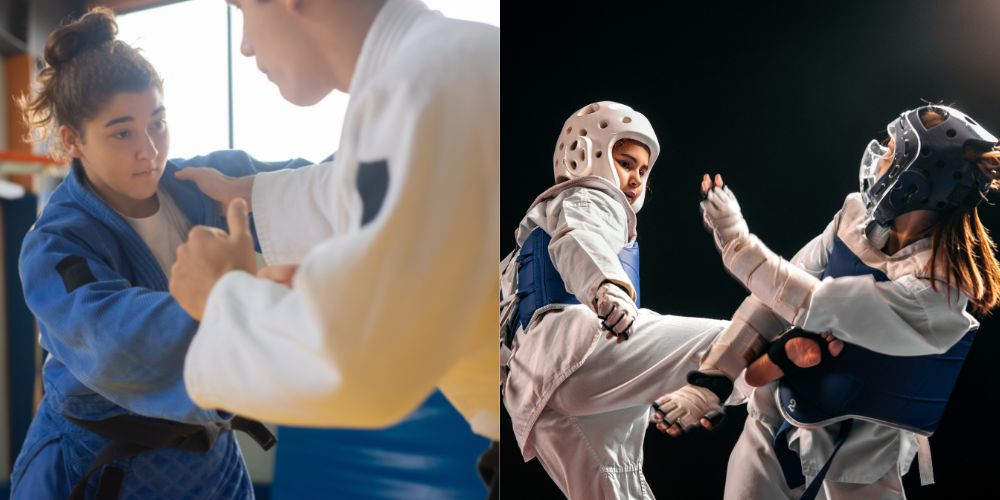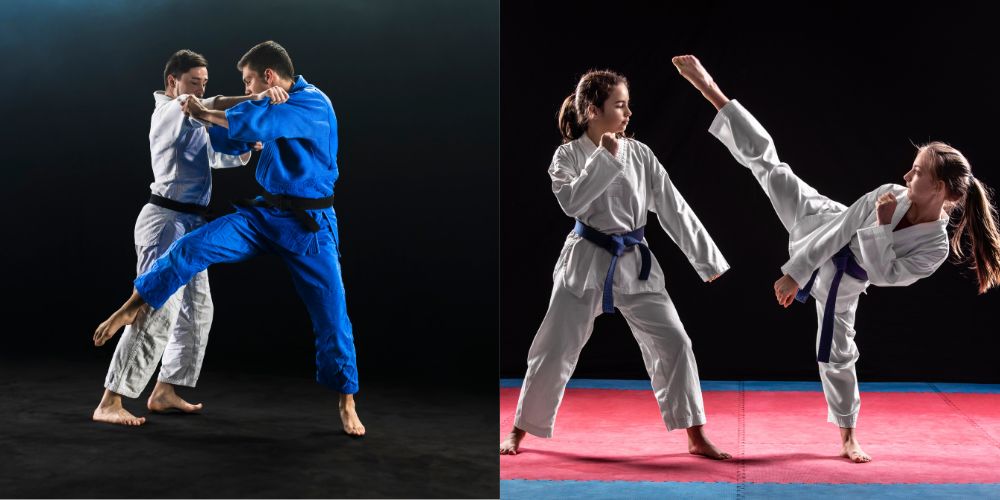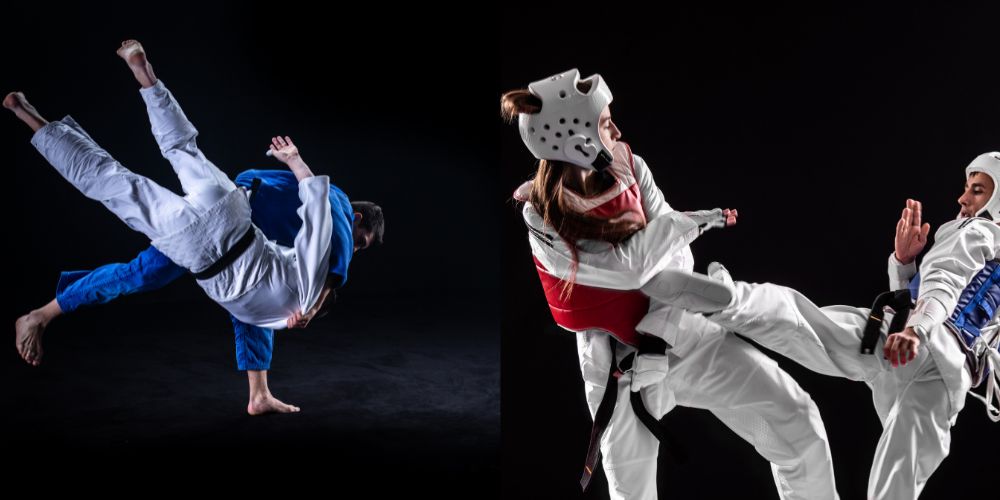Choosing a martial art is daunting, and detailed comparisons are handy in those situations. There are so many styles and sub-styles out there, but two of the most popular ones, thanks to them being Olympic sports, are Judo and Taekwondo. But what is the difference between them?
Judo is a Japanese grappling martial art that uses throws and grappling techniques to take an opponent to the ground and control him there. Taekwondo comes from Korea and is a striking martial art focused almost entirely on kicks.
From this short explanation, you can see that Judo and Taekwondo take diametrically opposite approaches to combat. However, there are still a lot of commonalities that tie them together. To make things easier for you, we will take a detailed look at both martial arts and see how they compare.
What Is Judo
Judo is a grappling-based Japanese martial art and an Olympic sport. The entire focus of Judo is to control and dominate an opponent on the ground using various throws, pins, and submission holds.
Judo is one of the premier grappling sports and the most popular form of wrestling where you can manipulate the opponent’s clothes, such as a Japanese kimono called a Judogi.
Judo was created by Jigoro Kano, who first mastered traditional Japanese jiu-jitsu, fading in popularity in Japan in the late 19th and early 20th centuries.
Master Kano improved the classic arts he learned in many aspects and emphasized freestyle practice and sparring instead of strict forms while also removing all forms of striking from them.
His efforts to popularize his art and its undeniable effectiveness led to Judo becoming the main martial art of the Tokyo Police Department.

How to Dominate Every Fight with Raw, Explosive Power No One Can Match
Discover the underground blueprint that has quietly turned MMA hopefuls into legends, using nothing but sheer, brute force and bulletproof conditioning techniques.
The innovations Kano introduced in Judo, like the use of colored belts to signify rank and the use of a gi, as well as the distinction between different training modalities, have been adopted and used by countless other martial arts.
A big part of Judo’s popularity lies in the fact that it has been an Olympic sport since 1964. Judo has heavily inspired many other martial arts, like sambo, Brazilian jiu-jitsu, and hapkido. It has been used as a foundation by many successful MMA fighters.
What Is Taekwondo
Taekwondo is the Korean national martial art and an Olympic sport. It is a striking martial art with a heavy focus on kicks. Taekwondo is characterized by its sports rules, which create fast-paced kicking battles decided by speed, accuracy, and agility.
The history of modern Taekwondo is linked with the ancient martial arts “Subak” and “Taekkyon,” which have been an essential part of different eras of Korea’s history.
The modern sport was created in the 20th century by the combined efforts of other traditional martial arts masters, whose combined efforts were officialized in 1959 with the creation of the Korea Taekwondo Association.
Today, there are two prominent organizations. Taekwondo is an extremely popular martial art. Its structure, well-developed dojo system, and competition scene make it very popular among kids.
There are two versions of Taekwondo today, the main one being the WTF, also known as Olympic Taekwondo. Taekwondo’s introduction as a demonstration sport in the 1988 Olympics and then as a full medal sport in 2000 greatly expanded its global reach and popularity.
Key Differences Between Judo & Taekwondo

Techniques
Judo techniques are classified into three categories, two of which are legal for sparring and competition. Each category is further broken down into sub-categories depending on the specifics.
- Nage-Waza (throwing techniques)
Throwing techniques are divided into standing techniques (Tachi-Waza) and sacrifice techniques (Sutemi-Waza). Then the standing throws can be hand techniques, hip techniques, or foot and leg techniques.
The sacrifice throws can be rear or side sacrifice techniques. Grabbing the legs is prohibited in modern Judo, effectively banning single and double-leg takedowns.
- Katame-Waza (grappling techniques)
Grappling techniques can be holding and pinning techniques, which can also score points, strangulation techniques, and straight joint locks.
- Atemi-Waza (striking techniques)
Striking techniques in Judo are included only in the kata training and are strictly forbidden in sparring and competitions.
Taekwondo techniques are not strictly categorized. In kata, there are many techniques, but kicks take 99% of the attention in competition and training.
Taekwondo kicks are fast, snappy, and accurate. In Taekwondo, there are front, side, roundhouse, back, hook, axe kicks, and various jumping and spinning variations.
Rules
Judo aims to throw the opponent to the ground, pin him for a period of time, or submit him using strangulation or a joint lock. A match can be instantly won by ippon which is awarded for a throw of the opponent on his back, forcing him to tap to submission or pin him for 25 seconds.
The next best score is called waza-ari, and a match is won when two waza-ari are scored (resulting in an ippon) for lesser throws and shorter pins. The least important points are called yuko.
If the contestants have yet to earn an ippon by the end of the 5-minute match period, the one with the better score wins.
Taekwondo has two main branches with different rules. The Olympic version of the sport does not allow any face punching, knees, or attacks below the waist.
Matches are contested over 3×2 minute rounds and can be won via a knockout or accumulation of points. Points are awarded for successful strikes to valid areas of the opponent.
- One point for a punch to the trunk protector
- Two Points for a kick to the trunk protector
- Four points for a turning kick to the trunk protector
- Three points for a kick to the head
- Five points for a turning kick to the head
- One point is awarded for every penalty (known as gam-jeom) given against the opponent.
Equipment
Judo is always practiced in a traditional uniform derived from the Japanese kimono called a “gi,” consisting of trousers and a heavy jacket held together by a colored belt that signifies the wearer’s rank.
The gi is an integral part of the tradition and the techniques, as it can be used and grabbed for all kinds of throws and submissions.
Taekwondo competitors must wear a gi called a dobok, which is very similar to all the other Asian martial arts uniforms. The colored belt system is similar to that found in Judo, karate, and other martial arts.
In competition, a full set of protective equipment must also be worn, including a trunk protector, a head protector, forearm and shin guards, gloves, sensing socks, and a mouth guard.
Judo vs. Taekwondo For Self-Defense

While both are good and will help you immensely against untrained opponents, Judo is superior to Taekwondo for self-defense. But self-defense is a deep and divisive topic. Real-world combat is far too unpredictable, chaotic, and influenced by many variables to be prepared for everything.
But some styles are much more realistic, and others are not. Usually, the more rules there are in a sport and the lighter the contact, the less effective it is in real life.
With that said, both Judo and Taekwondo have very strict rule sets that ban a lot of aspects of fighting. What makes Judo superior is that it is a full-contact grappling martial art, and a lot of street fights turn into close-range brawls, which is where Judo shines.
The ability to misbalance your opponent, manipulate his stance, use his clothing, and incapacitate him on the ground made Judo preferred by law enforcement in the first place and is still its main selling point for self-defense.
Realistic training, full power sparring, and competitions mean that Judokas are well prepared to tackle fully resisting opponents.
The downside of Judo in a real-life scenario is that it lacks striking, and if the Judoka cannot get a hold of his attacker, he may be in trouble. Then, if we include bladed weapons, getting too close is exactly the opposite of what you need to do.
On the other hand, Taekwondo has great distance strikes and footwork, which work great if there is enough space. Taekwondo kicks are lightning-fast and very powerful and can severely hurt anyone.
But in a real situation, there are rarely ideal conditions (space, slippery surfaces, clothing) to kick, let alone head kick with precision. The lack of meaningful punches and all forms of grappling make Taekwondo ill-prepared to deal with many situations.
But again, the Korean art may serve you very well in certain situations. Still, in my book, Judo is better in most self-defense scenarios.
Judo vs. Taekwondo For MMA

Judo and Taekwondo are not the best-represented martial arts in MMA, but they have still produced a satisfying number of high-caliber cage fighters and champions.
Taekwondo and Judo, like every other martial art except a few that closely resemble MMA, require extensive modification to be effective in the cage.
Taekwondo fighters like Anthony Pettis, Jair Rodriguez, and Valentina Shevchenko have upgraded their base Taekwondo skills with solid boxing and grappling and became deadly in MMA.
The accurate kicks, swift movement, speed, and agility in Taekwondo translate perfectly to MMA when the fighter builds up his skills in the other areas.
Similarly, Judo provides a good foundation, but instead of striking, it teaches world-class grappling that can also be used in MMA. Even though many Judo techniques initially used the gi, they also work without clothes.
Fighters like Ronda Rousey, Karo Parisyan, Satoshi Ishii, and many others have effortlessly ragdolled people in the cage thanks to their Judo throws and trips.
Both are equally good for MMA if the practitioner manages to translate his base skill into MMA. This variety makes MMA so spectacular and is why many vastly different martial arts find their place in the cage.
Who Wins a Fight Between Judo and Taekwondo?
MMA has taught us that the grappler usually beats the striker if both have no other skills. For the striker to win, he has to keep his distance and pick apart the grappler or knock him out coming in. This can be done with enough training.
Still, in a scenario where a Judoka and a Taekwondo practitioner are fighting, the overwhelming chance is that the Judoka will get in close and take the fight to the ground, where he decides when and how the fight ends.
Of course, the fighters’ mentality, skills, and conditioning determine each fight the most, so we can never say for sure what happens in each possible scenario. But from all the evidence in MMA and street fight videos, the Judoka will likely win the fight against Taekwondo.
Here is one such rare battle where the participants are not MMA fighters with a Judo and Taekwondo base but rather pure practitioners pitted against each other.
How to Choose Judo or Taekwondo?
As hugely popular Olympic disciplines, Judo and Taekwondo provide equally ample opportunities to train, compete, and evolve.
There are dojos for each in even smaller towns, and many countries have a well-developed competition scene, so availability and finding a reputable gym shouldn’t be an issue with either of them.
The choice between the two depends on whether you prefer grappling or striking. Still, we have to say Judo’s grappling is more realistic for street fighting and MMA than Taekwondo’s striking. Then the choice can be determined by physical qualities that make you better suited for one or the other.
You need to be fast, agile, and slim to succeed in Taekwondo. Judo requires a more powerful and dense physical profile. Still, you can train and enjoy both, regardless of your build. But it doesn’t hurt to spend your time practicing what your body is better suited to do.
Judo will teach you more practical self-defense skills and will make you stronger, while Taekwondo will always look more impressive.
In terms of effectiveness in MMA, both have suitable bases and a very well thought curriculum for children and youngsters. Ultimately, choosing what to do with your time is always yours, but time is finite, so choose wisely.

